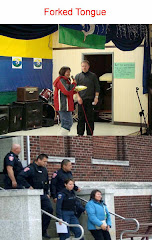Canadian Arrow president Kim Tyler said Wednesday he hoped to bring 150
mining jobs to the Sioux Narrows area, and production could begin at
their Kenbridge site as soon as 2010.
By Mike Aiken
Miner and News
Thursday May 01, 2008
Canadian Arrow president Kim Tyler said Wednesday he hoped to bring 150
mining jobs to the Sioux Narrows area, and production could begin at
their Kenbridge site as soon as 2010.
The company also hoped to bring in $108 million worth of construction,
as they get ready to open, and they could make a profit of $43 million
a year, according to their projections.
Tyler was addressing the Treaty 3 mining conference in Kenora Wednesday
at the Travelodge. Delegates included private industry, First Nations
and provincial staff in hopes of dealing with some highly controversial
topics.
He also noted he has a formidable challenge ahead of him, as he tries
to raise the money necessary for the project from financial
institutions who are suffering through the sub-prime credit crunch. The
company's stock closed at 36 cents a share Wednesday.
Anger from KI
Former regional chief Charles Fox, hosted the workshops, and he
reminded everyone of the volatility of the situation, when he referred
to band council members from Kitchenumaykoosib Inninuwug.
"Those people, who are in jail, are my cousins. They're my relatives …
As a person who was brought up and who believes very strongly in our
rights, it aroused anger," he told his audience.
Fox also offered a conciliatory note, when he said it was important for
those who lived together to get along with one another, for the benefit
of our young people. He noted 70 per cent of First Nations are under 25
years old.
"So there are challenges and there's opportunity," he said.
Efforts to reconcile
In his remarks, Treaty 3 Grand Chief Arnold Gardner stressed the
importance of having a rights-based approach to partnerships based on
the treaty signed between First Nations and the Crown in 1873.
"We're here to stay, and you're here to stay, so let's work together,"
he said.
Gardner also addressed Anishinabe members of the audience, noting
they'd been asleep for too long, and it was time for changes.
Kenora Mayor Len Compton also referred to the treaty, when he addressed
the conference Wednesday.
"We can move forward successfully, only if our treaty is respected," he
said.
While discussing their disagreements as part of the Common Land, Common
Ground discussions, the mayor said they discovered deep commonalities.
If they wanted to ensure lasting, local benefits for local people, then
they needed to get federal and provincial officials to respect the
treaty, he added.
Record growth expected
With more than 400 companies expected to work 308,000 mining claims in
the province this year, there could be $600 million worth of
exploration on 800 projects, according to the Ministry of Northern
Development and Mines.
Together, the province says the mining industry brings in an estimated
$426 million in federal, provincial and municipal taxes. However, the
local share is based on property assessment, not royalties, and it
excludes First Nations.
Northern Development and Mines representative Lori Churchill said the
government committed to resource benefit sharing in their Throne
Speech, and they'd recently added an aboriginal relations branch to the
ministry, in an effort to help resolve long-standing issues.
Queen's Park is also involved with the Northern Table talks that
include resource development, Far North Land Use Planning, as well as
discussion papers on consultations and resource revenue sharing.
The 43 mines in the province are expected to have a payroll of $18
billion, Churchill noted, during her presentation.
Resource Law explained
Treaty 3's Great Earth Law got a full endorsement from Tyler, who said
he'd been in discussions with the Grand Council staff for a year.
Like many junior mining companies, he was working in an office of two,
when he discovered the importance of consultations with First Nations.
He encouraged his peers to do the same, since the law brought certainty
to the development process.
"It sets up the rules for engagement, which is very, very good," he
said.
Essentially, companies who want to do business within Treaty 3 would
have to get permission from the Grand Council. This would include
agreements on benefit sharing, environmental and cultural issues.
Currently, companies can get permits from the province, without
permission from First Nations.
A short history lesson
Andrew Johnson, who's been involved in aboriginal politics for 23
years, explained how the Great Earth Law developed from both the
recreation of Anishinabe government through community consultations, as
well as a Bell telephone project involving the construction of lines
through Treaty 3 territory.
It was the first time the Grand Council took it upon themselves to
negotiate with the company directly for the benefit of First Nation
members. Before, Indian Affairs would arrange a settlement on behalf of
the nation, Johnson said.




